I’m sharing my exact counting coins lesson plans because let’s face it, counting coins is a hard standard in 2nd grade. This is the first time many students are exposed to counting coins. There is no standard in first grade about counting money.
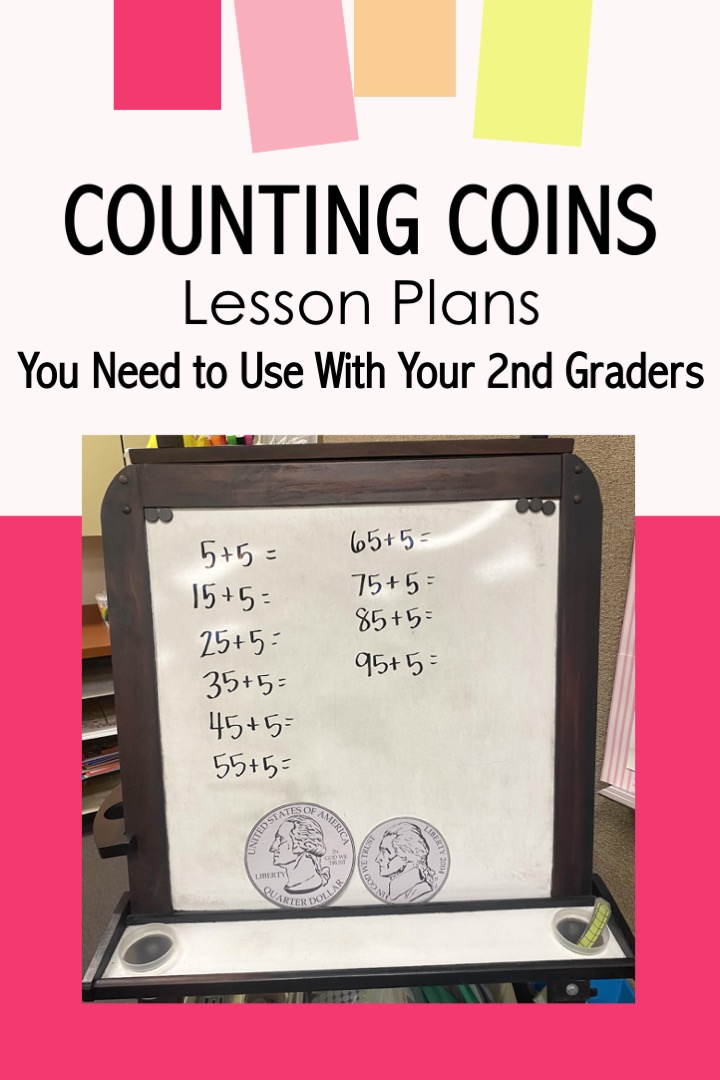
I’m sharing my exact counting coins lesson plans that have helped my 2nd graders find success with counting coins.
During my first year teaching when I got to our counting coin lessons in our curriculum, it was way too difficult for students. This curriculum already expected them to recognize all the coins. My students did not know the coins or their values but we just jumped into having them count them. It was a disaster. I remember being disappointed that a lot of students did not do well on that unit test.
The next school year, I knew I needed to change things. So I rewrote the counting coin lesson plans to prepare students for those lessons in our curriculum. The results were incredible! Students were ready for those lessons because they knew how to identify the coins and already had a jump start with counting coins.
So I thought it would be helpful to share my counting coins lesson plans today in this blog post.
Counting Coins Lesson Plans
I start my counting coins lesson plans early in the school year. I want my students to be prepared for when we get to those lessons in our curriculum in January.
What’s the first thing students need to know? They need to know how to identify each coin and know the coins’ values.
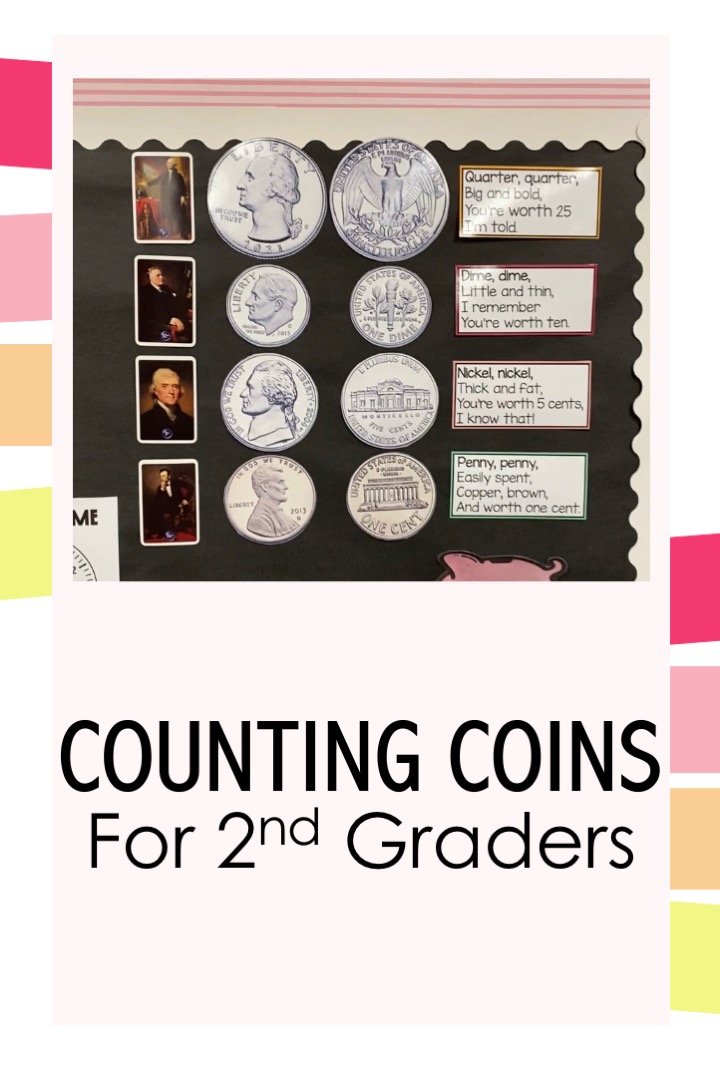
Having visuals and rhymes is a very powerful tool when teaching counting coins for 2nd graders.
To do this I have clipart of the coins that I have printed off and put up on our Math Wall. Next to each coin is a little rhyme that helps students remember its value. As part of our routine math warm-up for the day, I have students say those rhymes with me. After a couple weeks of doing this, students can easily tell me how much each coin is worth. Find the coin cutouts and rhymes I use here.
Some students can easily mix up nickels and quarters. They are both big, silver coins. I help students look for the differences in the coins. I also like to teach students a little bit about the presidents on the coins. Thomas Jefferson is on the nickel. You can see that he has a collar on his shirt. George Washington is on the quarter. He does not have a collar. The nickel has Thomas Jeffereson’s house on the back. I show my students a picture of me at Thomas Jefferson’s house when I visited it during a trip to Washington D.C. Helping students visualize these things helps them identify these coins.
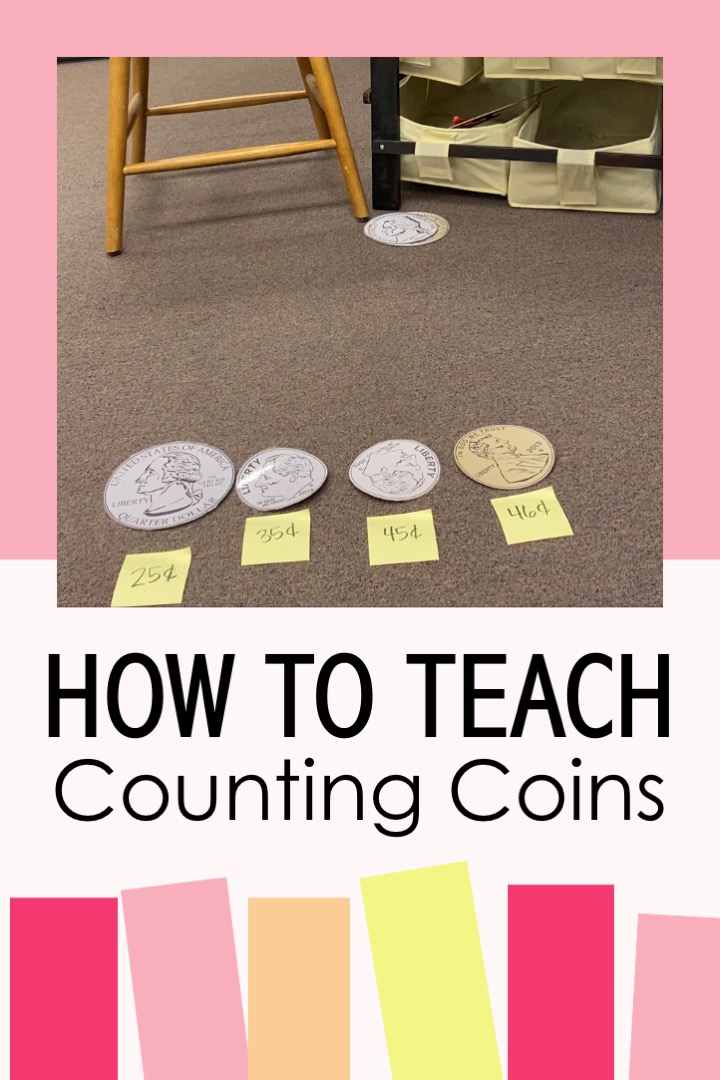
These counting coins printable resources make it easy to practice counting coins as a class.
Once students know how to identify coins and know their values, I teach them how to count coins. I have more big cut outs of the coins. I mix these up behind my back and set out a few on the ground. Then I call a student up to help me put the coins in order from greatest value to least value. After that, I model how to start with the coin with the highest value and count on. Over the next couple of weeks we continue this activity as a math warm up but I get students more involved by having them help me count the coins.
Then students are ready to move onto a different counting coin activity as a math warm-up. I have a treasure chest on our Math Wall. It is laminated and has velcro dots on it. I also have coins with velcro dots. I put coins on the treasure chest and students have to help me count the coins. Then students help me write in the amount in cents and in dollars.
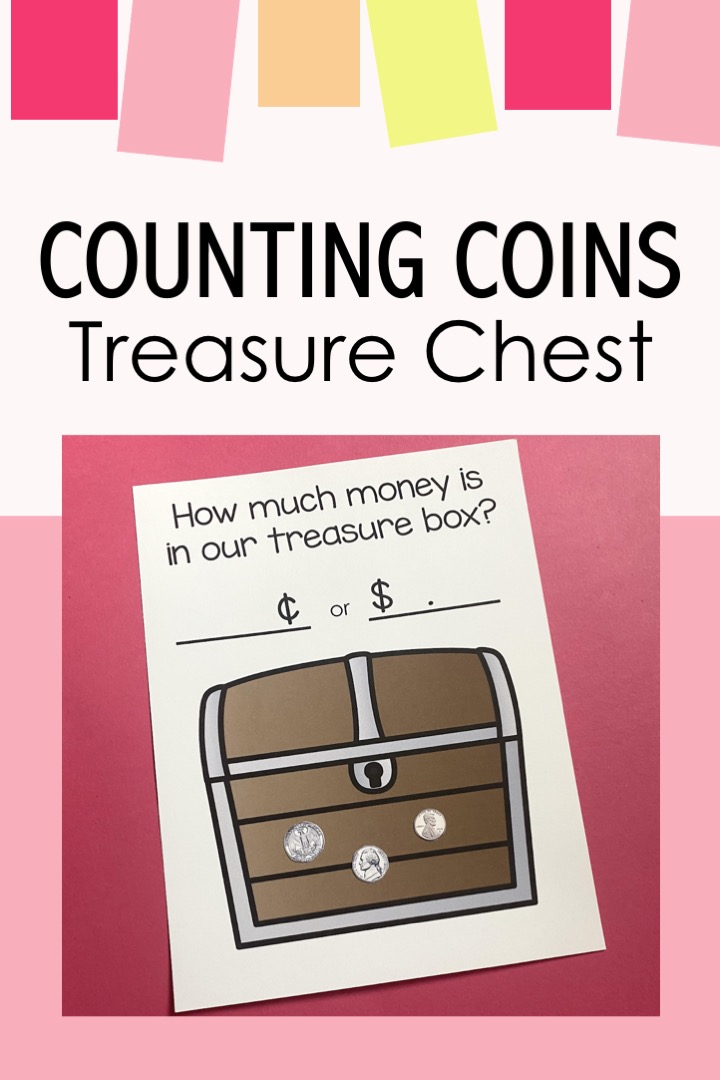
Provide whole-group counting coins practice with this treasure chest activity.
We continue this math warm-up until our official counting money lesson plans from our curriculum in January. Find this treasure chest activity here.
But I still want to get students some more independent type practice with counting coins before January. So I include some other counting money activities into our counting coins lesson plans.
Counting Coins Activities
When I know our regular math lesson is a shorter one, I have students do a counting coin scoot activity. This is where I tape up task cards around our classroom. Students have a recording sheet and something hard to write on. They go around the classroom, count the coins on the task cards, and record their answers on the sheet.
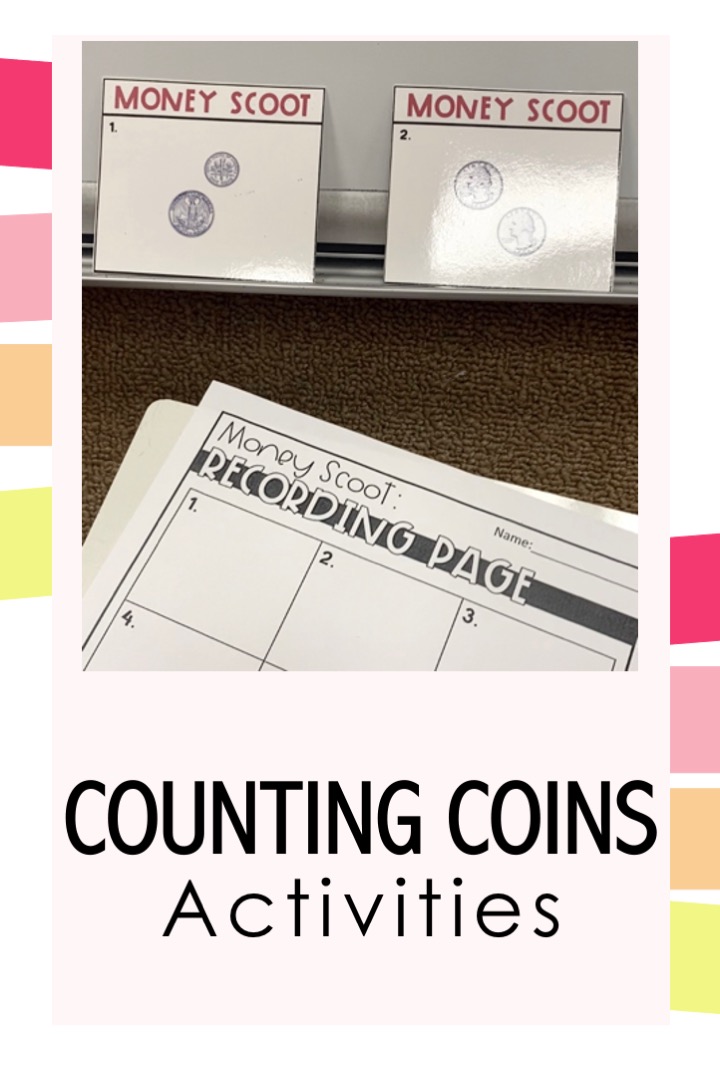
Students need engaging counting coins activities when learning how to count coins.
Students may need a little support with this as first. That is why I have different versions of this scoot activity. The first version only has amounts up to 25 cents, the next version has amounts up to 75 cents, and the last version has amounts up to a dollar.
Since this is our first counting coins activity, I have students do the version with amounts to 25 cents. I also have students work with a partner so they can give each other support. Since this is earlier in the school year, I know students are still practicing 2-digit addition. So I let students use a hundreds chart if needed. Learn more about teaching how to add on a hundreds chart in this blog post here.
Later on I’ll have students complete the other versions of this scoot activity. Find the scoot activities I use here.
I also like to give students a little counting coins pre-test. This helps me know where each individual student is at with counting coins. I partner students up with a classmate that scored similar on this test. Then I get them a set of cards on that level. They match the cards together. One card has pictures of the coins and the other has its amount.
When students finish that set, I give them a set that is one level higher to give them a little bit of a challenge. Find this counting coin matching activity here.
Now remember, I’ve only had students do these activities on days when we have finished our regular math lesson early. I still haven’t had a full counting coins lesson yet. This is all pre-teaching.
But I do like to give students even more practice before our regular curriculum counting coin lesson plans, so I have them play some counting coin games.
Counting Coin Games
I like to teach my students how to play these counting coin games and then I set them out as fast finisher options. That means that once students finish an assignment, they can go play a game with some classmates. Read my full list of fast finisher activities in this blog post here.
I have different versions of these counting coin games. These include versions of amounts to 25 cents, versions with amounts to 75 cents, and versions with amounts to a dollar. I set out the smaller amount version first, and then later in the school year will set out the higher amounts.
Setting these counting coin games out as fast finishers works great because students get fun counting coins practice without taking up extra class time.
So here are the counting coin games I have my 2nd grade students play:
Counting Coins Don’t Eat Pete
This is a fun and interactive game that 2nd graders love. To prepare for this game, I just print out a sheet with 12 squares, each containing different coin combinations.
Students play in small groups, using small objects like candy, dried beans, counters, or mini erasers to cover the squares.
One student steps away while the rest secretly choose one square to be “Pete.” When the student returns, they pick up the markers one at a time, saying the total value of the coins in each square. If they pick the one marked as Pete, the group shouts, “Don’t Eat Pete!” After Pete is found, the next player gets to take their turn.
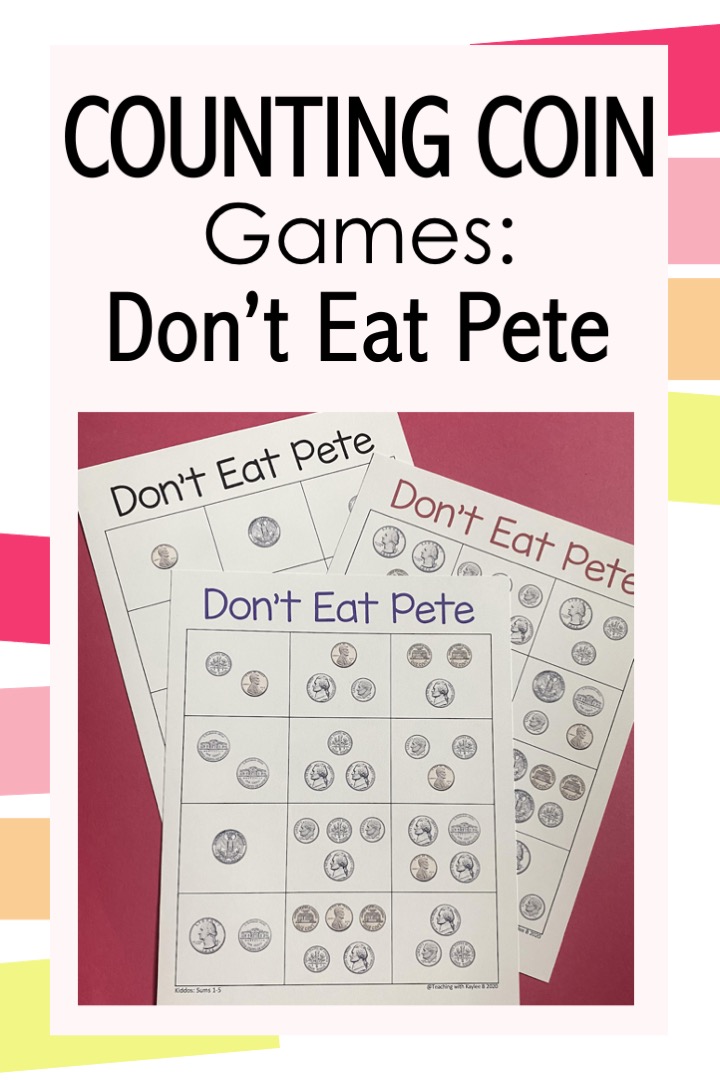
This is a favorite of all the counting coin games my 2nd grade students play.
I love this game because it’s incredibly easy to prep—just print the sheet and slip it into a page protector. There’s no need for cutting or laminating! You can grab this Counting Coins Don’t Eat Pete game here.
Counting Coins War Game
Money War is a classroom favorite for practicing coin countings. In this card game, students gather in small groups and deal out all the cards evenly. Without looking at their cards, they stack them face down in front of them. On the count of three, each player flips over their top card. The player with the higher coin value wins the round and collects all the cards.
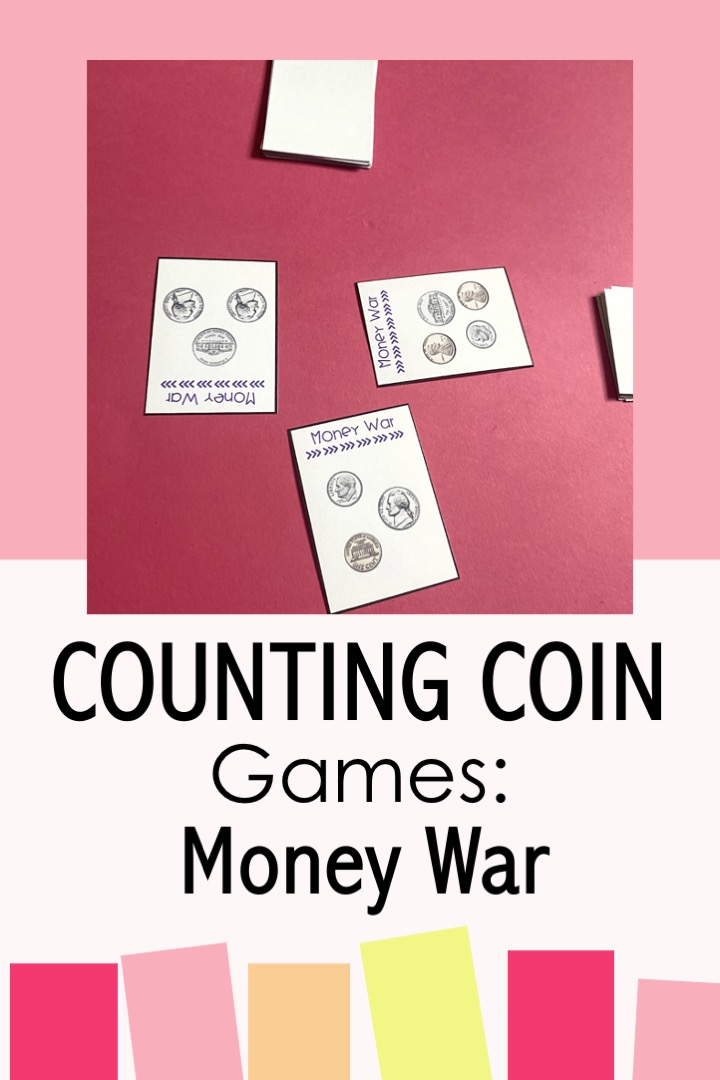
Easily incorporate this game into your counting coins lesson.
If two players reveal cards with the same value, the cards are placed in the center, and a new round is played. The winner of the next round takes the cards from the middle. The goal is to collect the most cards by the end of the game or be the last player with cards.
Find this counting coins war game to play in your classroom here.
Counting Coins Memory Match
Counting Coins Memory Match puts a fun twist on the classic memory game! Instead of pictures, the cards feature coins and their matching amounts.
At first, I thought this might be too easy for my 2nd grade students, but it quickly became one of their favorite classroom activities.
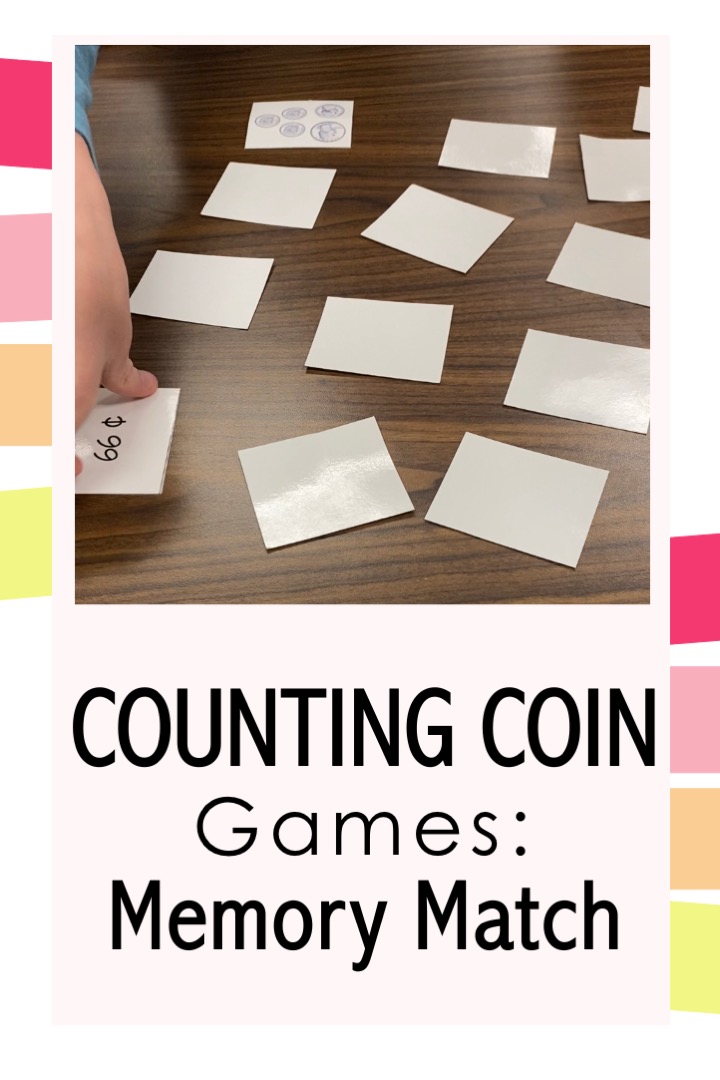
Give practice with counting coins 2nd grade students need with this fun counting coins memory match game.
To play, students arrange the cards in rows and columns on the floor or a table. They take turns flipping over two cards—if they find a match between a set of coins and its value, they keep the cards and get another turn. Play continues until all the cards are matched, and the student with the most pairs at the end is the winner!
Find this Counting Coins Memory Match game here.
So let’s do a quick recap of my counting coins lesson plans that prepare students for our actual curriculum counting coins lessons. First I pre-teach how to identify coins in our math warm-ups using our coin rhymes. I also use big coin cut outs and the treasure chest activity to practice counting coins together as a class.
Then I have students complete different counting coins activities after lessons finish early. This includes the scoot activity and the matching activity.
I also have students play counting coin games as fast finisher activities throughout the school year. I set out harder versions of these games when students are ready.
Once I made these changes in how I taught counting coins, it really did make all the difference. Our counting coin lessons from our curriculum went so much better. Students knew the coins and their amounts. They could actually accurately count coins! Students scored better on the unit test. But the best part, I saw their confidence in their math skills increase. Students loved our counting coin lesson plans.
I even heard from parents that when their child came home from school, they tried to find coins around the house to count them up. They were applying the things they learned in class!
I’ve put all the counting coin resources I’ve mentioned in this blog post in one money-saving bundle. Find this bundle here.
I know I have focused on how to teach counting coins in this blog post, but students also need to learn how to count dollar bills. For tips on how to teach counting dollar bills, read this blog post here.
Learn more about the counting coins games I mentioned before in this blog post here.


